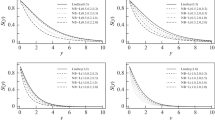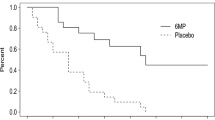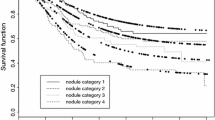Abstract
This paper proposes a new survival model, called Poisson Inverse-Gaussian regression cure rate model (PIGcr), which enables different underlying activation mechanisms that lead to the event of interest. The number of competing causes of the event of interest follows a Poisson distribution and the time for the event follows an Inverse-Gaussian distribution. The model takes into account the presence of censored data and covariates. For inferential purposes, a Bayesian approach via Markov Chain Monte Carlo was considered. Discussions on the model selection criteria, as well as a case deletion influence diagnostics are addressed for a joint posterior distribution based on the \(\psi \)-divergence, which has several divergence measures as particular cases, such as Kullback–Leibler (K–L), \(J\)-distance, \(L_1\) norm and \(\chi ^2\)-square divergence measures. The procedures are illustrated in artificial and real data.











Similar content being viewed by others
References
Bacanli S, Demirhan YP (2008) A group sequential test for the inverse gaussian mean. Stat Pap 49(2):377–386
Balka J, Desmond A, McNicolas P (2009) Review and implementation of cure models based on first hitting times for wiener processes. Lifetime Data Anal 15:147–176
Balka J, Desmond AF, McNicholas PD (2011) Bayesian and likelihood inference for cure rates based on defective inverse gaussian regression models. J Appl Stat 38(1):127–144
Brooks SP (2002) Discussion on the paper by Spiegelhalter, Best, Carlin, and van der Linde. J R Stat Soc B 64:616–618
Cancho V, Ortega E, Bolfarine H (2009) The log-exponentiated-weibull regression models with cure rate: local influence and residual analysis. J Data Sci 7:433–458
Cancho V, Ortega E, Paula G (2010) On estimation and influence diagnostics for log-birnbaum-saunders student-t regression models: Full bayesian analysis. J Stat Plann Inference 140(9):2486–2496
Cancho V, Dey D, Lachos V, Andrade M (2011a) Bayesian nonlinear regression models with scale mixtures of skew-normal distributions: estimation and case influence diagnostics. Comput Stat Data Anal 55(1):588–602
Cancho V, Rodrigues J, de Castro M (2011b) A flexible model for survival data with a cure rate: a bayesian approach. J Appl Stat 38(1):57–70
Cancho VG, de Castro M, Rodrigues J (2012) A bayesian analysis of the conway-maxwell-poisson cure rate model. Stat Pap 53(1):165–176
Carlin BP, Louis TA (2001) Bayes and empirical bayes methods for data analysis, 2nd edn. Chapman & Hall/CRC, Boca Raton
Chhikara R, Folks L (1989) The inverse Gaussian distribution: theory, methodology, and applications. Marcel Dekker, New York
Cobre J, Perdona GSC, Peria FM, Louzada F (2013) A mechanistic breast cancer survival modelling through the axillary lymph node chain. Stat Med 32(9):1536–1546
Cook RD (1986) Assessment of local influence. J Roy Stat Soc B 48:133–169
Cook RD, Weisberg S (1982) Residuals and influence in regression. Chapman & Hall/CRC, Boca Raton
Cooner F, Banerjee S, McBean AM (2006) Modelling geographically referenced survival data with a cure fraction. Stat Methods Med Res 15:307–324
Cooner F, Banerjee S, Carlin BP, Sinha D (2007) Flexible cure rate modeling under latent activation schemes. J Am Stat Assoc 102:560–572
Cordeiro GM, Rodrigues J, de Castro M (2012) The exponential com-poisson distribution. Stat Pap 53(3):653–664
Cowles MK, Carlin BP (1996) Markov chain Monte Carlo convergence diagnostics: a comparative review. J Am Stat Assoc 91:883–904
Dey D, Birmiwal L (1994) Robust bayesian analysis using divergence measures. Stat Probab Lett 20(4):287–294
Folks JL (2007) Inverse Gaussian distribution. The encyclopedia of statistical sciences, 6th edn. Wiley, New York
Folks JL, Chhikara RS (1978) The inverse gaussian distribution and its statistical application - a review. J R Stat Soc Ser B 40(3):263–289
Gamerman D, Lopes HF (2006) Markov Chain Monte Carlo: stochastic simulation for Bayesian inference, 2nd edn. Chapman & Hall/CRC, Boca Raton
Geisser S, Eddy W (1979) A predictive approach to model selection. J Am Stat Assoc 74:153–160
Gelfand AE, Dey DK, Chang H (1992) Model determination using predictive distributions with implementation via sampling based methods (with discussion). In: Bernardo JM, Berger JO, Dawid AP, Smith AFM (eds) Bayesian statistics. Oxford University Press, Oxford, pp 7–167
Geweke J (1992) Evaluating the accuracy of sampling-based approaches to the calculation of posterior moments. In: Bernardo JM, Berger JO, Dawid AP, Smith AFM (eds) Bayesian statistics, 4th edn. Oxford University Press, Oxford, pp 169–188
Gu Y, Sinha D, Banerjee S (2011) Analysis of cure rate survival data under proportional odds model. Lifetime Data Anal 17(1):123–134
Hanagal DD, Dabade AD (2013) Modeling of inverse gaussian frailty model for bivariate survival data. Commun Stat Theory Methods 42(20):3744–3769
Ibrahim JG, Chen M-H, Sinha D (2001) Bayesian survival analysis. Springer, New York
Johnson NL, Kotz S, Balakrishnan N (1994) Continuous univariate distributions, 2nd edn. Wiley, New York
Kim S, Chen M, Dey D (2011) A new threshold regression model for survival data with a cure fraction. Lifetime Data Anal 17(1):101–122
Kirkwood JM, Ibrahim JG, Sondak VK, Richards J, Flaherty LE, Ernstoff MS, Smith TJ, Rao U, Steele M, Blum RH (2000) High- and low-dose interferon alfa-2b in high-risk melanoma: first analysis of intergroup trial E1690/S9111/C9190. J Clin Oncol 18:2444–2458
Kotz S, Leiva V, Sanhueza A (2010) Two new mixture models related to the inverse gaussian distribution. Methodol Comput Appl Probab 12:199–212
Leiva V, Sanhueza A, Kotz S, Araneda N (2010) A unified mixture model based on the inverse gaussian distribution. Pak J Stat 26:445–460
Louzada-Neto F (1999) Poly-hazard regression models for lifetime data. Biometrics 55:1121–1125
Mazucheli J, Louzada F, Achcar JA (2012) The polysurvival model with long-term survivors. Revista Brasileira de Probabilidade e Estatıstica 26:313–324
Peng F, Dey D (1995) Bayesian analysis of outlier problems using divergence measures. Can J Stat 23(2):199–213
Rodrigues J, Cancho V, de Castro M, Louzada-Neto F (2009) On the unification of long-term survival models. Stat Probab Lett 79:753–759
Sanhueza A, Leiva V, Balakrishnan N (2008) A new class of inverse gaussian type distributions. Metrika 68:31–68
Schrödinger E (1915) Zur theorie der fall-und steigversuche und teilchen mit brownscher bewegung. Phys Z 16(16):289–295
Seshadri V (1993) The inverse Gaussian distribution: a case study in exponential families. Claredon, New York
Seshadri V (1999) The inverse Gaussian distribution: statistical theory and applications. Springer, New York
Spiegelhalter DJ, Best NG, Carlin BP, van der Linde A (2002) Bayesian measures of model complexity and fit. J R Stat Soc B 64:583–639
Stogiannis D, Caroni C (2012) Tests for outliers in the inverse gaussian distribution, with application to first hitting time models. J Stat Comput Simul 82(1):73–80
Tojeiro CVM, Louzada F (2012) A general threshold stress hybrid hazard model for lifetime data. Stat Pap 53(4):833–848
Tsodikov AD, Ibrahim JG, Yakovlev AY (2003) Estimating cure rates from survival data: an alternative to two-component mixture models. J Am Stat Assoc 98:1063–1078
Tweedie MCK (1957) Statistical properties of the inverse gaussian distribution. Ann Math Stat 28:362–377
Weiss R. (1996). An approach to Bayesian sensitivity analysis. J R Stat Soc Ser B, pp 739–750.
Yakovlev AY, Tsodikov AD (1996) Stochastic models of tumor latency and their biostatistical applications. World Scientific, Singapore
Acknowledgments
The authors are grateful to two anonymous referees and the Editor for theier careful reading and comments, which have considerably improved the paper. The research was partially supported by CNPq and FAPESP, Brazil.
Author information
Authors and Affiliations
Corresponding author
Rights and permissions
About this article
Cite this article
Suzuki, A.K., Cancho, V.G. & Louzada, F. The Poisson–Inverse-Gaussian regression model with cure rate: a Bayesian approach and its case influence diagnostics . Stat Papers 57, 133–159 (2016). https://doi.org/10.1007/s00362-014-0649-8
Received:
Revised:
Published:
Issue Date:
DOI: https://doi.org/10.1007/s00362-014-0649-8




